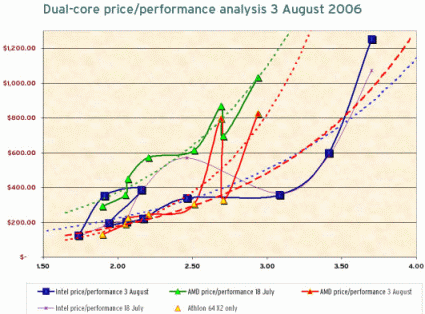Intel Core 2 Duo prices fall well below AMD price/performance curve
Santa Clara (CA) - For the past few weeks, TG Daily has been tracking the progression of AMD dual-core processor prices, before and since Intel's announcement of Core 2 Duo and Core 2 Extreme processors. Just before the announcement, AMD officials promised they would reduce prices to meet or beat the price/performance curve set by Intel. Since that time - at least with regard to the Athlon 64 X2 series - AMD has succeeded, by TG Daily's calculation.
But lost amid that part of the analysis is the flip side of the data: If the shoe were to be placed on the other foot, as it were, Intel's Core 2 Duo and Core 2 Extreme desktop processor prices would fall well below the price performance curve set by AMD, according to today's data from PriceGrabber and Froogle.
Using today's data, along with extremely sophisticated analysis tools (Microsoft Excel), we created a best-fit exponential curve which most closely represents the current state of AMD dual-core processor prices, including the Athlon 64 X2 and Athlon FX series. Then we used our performance model from two weeks ago, which compares the relative scores of all AMD and Intel dual-core processors, using Tom's Hardware Guide benchmark data, against the performance of an Intel single-core, 2 GHz Pentium 4. For this performance index, we chose five performance categories, and made the results from each one reflect 20% of the total score. The final index represents relative performance against the P4, where the P4 is automatically scored at 1.0. Here, a non-overclocked Core 2 Extreme X6800 scored a 3.70 overall, while AMD's top-of-the-line FX-62 scored a 2.94. Our complete scoring data is introduced in this story from 20 July.
A price/performance curve is generated by plotting the actual average sale prices for each CPU, as projected by PriceGrabber (with Froogle filling in when sales were too low for PriceGrabber to track) against the performance index. Thus with Intel's 3.70-indexed Core 2 Extreme selling for $1,253 according to 3 August data, and its 1.94-indexed Pentium D 930 selling for $197, you can imagine a tent-shaped arc - rather than a straight line - connecting all the other processors in-between, and extending down to the lower-order Pentium D 800 series.
AMD's current problem is that both its FX-62 and its discontinued FX-60 - whose remaining inventory is currently being sold off - are selling at artificial premiums. Were they not, it would seem AMD's price/performance curve would be a gentler slope. We wanted to know, if the FX-60 and FX-62 were taken out of the picture, and the Athlon 64 X2s were left alone to set a relative price/performance curve for AMD, how much of a difference would that make with regard to the relative fairness of Intel's Core 2 Duo pricing?
Our updated chart continues to show the dotted green trend line representing the price curve for AMD processors on 18 July, prior to both Intel's and AMD's announcements. The dotted red trend line shows the curve based on AMD's much lower prices, effective today. The dotted blue line represents Intel's current price/performance curve. But this time, we've added a new trend line: The dashed red line (with the longer strokes) represents AMD's trend with the FX processors excluded. Notice how close it is to Intel's; remove FX's artificial premiums, and it nearly follows the dotted blue line. However, that blue line also takes into account Intel's own artificial premium, which today keeps street prices of Core 2 Extreme over $1,200, while the next processor down the scale - the Core 2 Duo E6700, with not much lower performance score - sells on average for $599 - less than half.
While excluding the FX series brings the trend line down, that fact only serves to underscore the relative performance values of both Core 2 Duo processors, whose plot points fall well below the adjusted curve. The Core 2 Duo E6600 currently sells on average for $365; if it were to follow the curve set by the Athlon 64 X2 processors alone, it could get away with selling for as much as $524.71, by our projections. In other words, the E6600 for 31.8% less than what a theoretical Athlon 64 X2 CPU would sell for, if it shared the E6600's performance score of 3.08. The E6700, meanwhile, sells for 17.8% less than the $728.38 it would have to sell for to compete with a theoretical Athlon 64 X2 with a score of 3.41. Still, the X6800 establishes Intel's premium, selling for 29.3% more than the competitive point of $969.13.
Get Tom's Hardware's best news and in-depth reviews, straight to your inbox.
Putting the FX series back into the equation, the calculations start to seem unfair. They drag the AMD curve up so far, so fast, that a comparable Intel X6800 could sell for under $2,470.31 and still be competitive. An E6700 could theoretically sell for $1,572.57 or less, and an E6600 could sell for $936.13 or less.
If AMD were to enter a new and improved FX processor into its product line soon, it could conceivably cut the FX-62 price to compensate, and thus drive its entire product line well within or below Intel's curve. The almost anomalous-seeming price of the FX-62 seems to point to that possibility.
On the low side of the AMD curve, the real-world Athlon 64 X2s remain quite competitive, as their street prices continue to show declines. The 5000+ model is now selling for an all-time low of $328 on average, after selling for as high as $697 just three weeks ago. The unofficially discontinued 4800+ continues its decline as well, down to $305 - a drop of almost 6% from yesterday. And the 4600+ at $245 - down 5% from just yesterday - represents a markup of only five bucks from AMD's recommended processor-in-a-box price, announced last 24 July.
